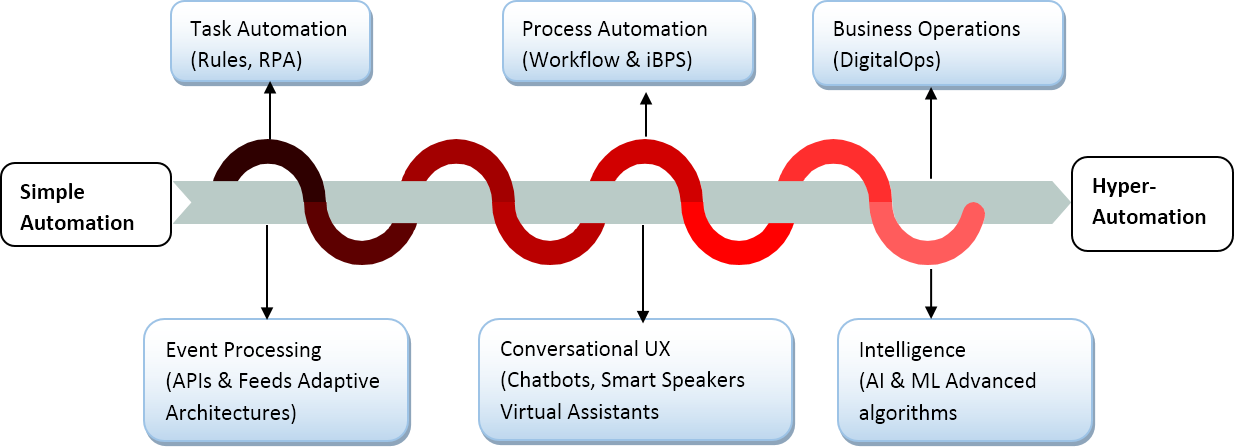Hyper-Automation is an end to end automation process which includes the power of multiple technologies, from Robotic Process Automation (RPA) to Machine Learning (ML) and Artificial Intelligence (AI).
Tools like RPA, Machine Learning and Artificial Intelligence operating to automate complex business processes, Including where subject matter experts were once required. Hyper-Automation is a means for real digital transformation.
Hyper-Automation is the continuing integration of software into the business processes. This is similar to more machines doing more things. It is the next step of digital transformation for businesses to remain competitive. If you're a digital company, you’re probably familiar with many of the automation benefits, such as:
- Consistent products and services
- More efficient products and services
- Fewer errors in the supply chain
- More effective use of data throughout the business
How is Hyper-Automation Different from Regular Automation?
When the term automation comes, terms like Robotic Process Automation will come to mind first. But hyper-Automation takes an ecosystem of technologically advanced tools and combines them to create a new way to automation.
It means that low-value tasks with automation software, machine learning and advanced artificial intelligence are performed optimally so that outputs can be generated automatically and run efficiently with little or no human interference. Hyper-Automation will then build, together with humans, a workforce that is always aware, agile are able to use data and insights for fast and accurate decision-making.
How does Hyper-Automation work?
According to Gartner, RPA enriched by AI & ML becomes the core enabling technology of Hyper-Automation. Combining RPA and AI Technologies offers the power and flexibility to automate where automation was never possible before, undocumented processes that rely on unstructured data inputs.
Types of automation that comprise Hyper-Automation:
- Robotic Process Automation
- Intelligent Document Processing
- Intelligent Process Discovery
- Advanced Analytics
- Digital Operational Tools
Benefits of Hyper-Automation:
Workforce enablement: Employees are able to automate many processes within their role, and get more jobs done, faster, with the resources available to them. Minimizing manual tasks enables them to focus on more impactful work, like planning and strategy.
Employee upskilling: With automation no longer reliant solely on IT, any business user can become an automation leader within their own department, benefiting both tech and non tech-minded employees.
Systems integration: With Hyper-Automation, a company’s advanced technology and data systems can communicate seamlessly with the power of integrations.
Digital agility: With all modes of automation working closely together, the business will step beyond a single technology's one-off advantages to a state of true digital agility and versatility at scale.
Return on investment: Businesses can monitor the exact ROI realized based on the automated processes, streamlined operations, and saved time and money on a weekly, monthly, and annual basis using key analytics. End-to-End process automation: automation alone can complete single and simple tasks. Intelligent automation can focus on entire processes that contain both structured and unstructured data.
Path to Hyper-Automation:

Why Hyper-Automation is going to be a top digital strategy for 2020 and beyond:
Hyper Automation offers a lot of benefits to the business by giving access to collaborative intelligence where humans and technology work side by side so that they can perform their roles optimally. As employees don’t need to perform repetitive tasks, they can be educated to work with automation tools, wisely and with intention, and learn the latest business and marketplace information through machine learning. They can also teach how to interpret AI-enabled decision-making, find creative solutions to resolve problems and get more engaged with their business.
Once Hyper-Automation is incorporated into your business it will help to reduce human effort by doing a lot of work in a lesser amount of time, reduce the risk of human errors as machines are calibrated for precision, improve the quality of jobs by eliminating deadly, exhausting, and dangerous for humans processes and leads to increased productivity and higher output.
But before any implementations, companies must think and identify areas and processes where automation is really needed. Business leaders must make a business plan and estimate the return on investment, and of course train existing personnel to make the most of automation instead of thinking that automation will take their job.
Hyper-Automation in Energy & Utilities and Oil & Gas Industries:
Hyper-Automation can help to build bots that carry out business processes intelligently to help start Hyper-Automation of the energy trading industry. Some of the relevant use cases are given below.
Oil & Gas Industry:
- Hyper-Automation of upstream operations
- Data Entry & Reporting of exploration & production
- Audit trail and inspections
- Contract man power management
- Data Analytics and Lease Management
Mining Industry:
- Tenement Management
- Manufacturing or Plant data updating
- Financial Department Reports
- Attendance and timing monitoring of Employees
- Contracts process management
- Stock Management
Utilities Industry:
- Data validation and customer onboarding
- Order Management
- Financial department Reporting
- Energy trading transaction reconciliation
Hyper-Automation mistakes to avoid:
- Without any business process strategy or plan starting Automation
- Automating processes before they’re optimized
- Automating the wrong processes
- Automating unknown processes
Hyper-Automation does not mean the end of human resource jobs; rather, it will focus more on value-based roles. Providers of Data Analytics services understand that machine learning helps businesses stay abreast with competitors. Machine learning algorithms can more efficiently identify data patterns and trends and generate different scenarios. This technology can increase productivity, save time and reduce costs. It also makes Automation services effortless by eliminating possible human errors. The application is very useful to all leading content management solutions, healthcare organizations, and pharmaceutical companies running clinical trials, law firms, insurance companies, remote sales offices, and any other industry that processes a large number of forms every day.

